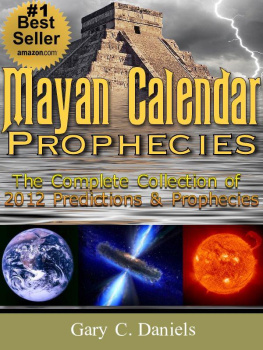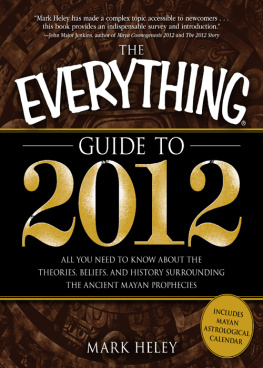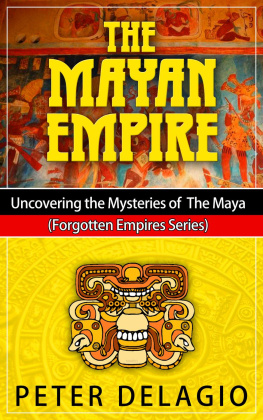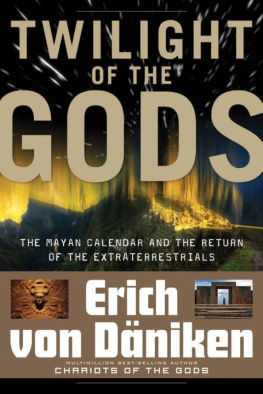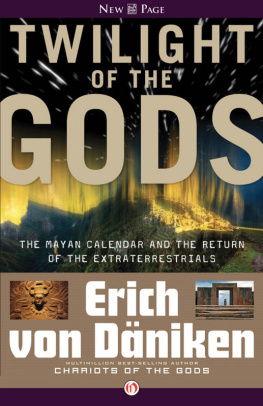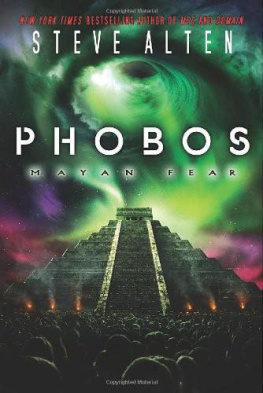Mayan Calendar Prophecies:
The Complete Collection of 2012 Prophecies & Predictions
(Parts 1-4)
_____________
What the Mayan Civilizations History & Mythology Can Tell Us About Our Future
Gary C. Daniels
Mayan Calendar Prophecies : The Complete Collection
Part 1: Predictions for 2012 and Beyond
Part 2: 2012- New Age of Disasters
Part 3: Cycle of Cosmic Catastrophes
Part 4: The 2012 Prophecy
2012 Gary C. Daniels
All rights reserved. No part of this publication may be reproduced, stored in a retrieval system, or transmitted in any way or by any means, electronic, mechanical, photocopying, recording or otherwise, without the prior written permission of the copyright holder.
Cover Artwork by Victor Habbick
Cover Design by Gary C. Daniels .
Visit me at:
www.TheRealMayanProphecies.com
Or like my Facebook page
For my wife, Lina, and daughter, Savannah. May our future be bright.
Table of Contents

I. Background
1. Prophecyor Predictions?
What is the difference between a prophecy and a prediction? A prophecy is usually the result of some type of vision or divine intervention received by a spiritual specialist like a shaman or priest. A prediction, on the other hand, can be made by anyone through careful observations that lead to the detection of a pattern. Meteorologists make predictions every night on your local news based not on divine intervention but by careful observation of data and then applying their knowledge of weather patterns to this data to predict what may happen next.
As Mayan scholar David Stuart noted in his book The Order of Days: The Mayan World and the Truth About 2012 , the Mayan prophetic books known as Chilam Balam utilized past events to predict future events. He noted that Mayan prophets did not simply receive visions and make random predictions. Instead they created a careful analytical system that looked for patterns in past historical events that took place in previous periods called katuns and then from these tried to make projections into the future. In fact, this analytical system sounds very similar to modern scientific forecasting.
The book you are reading now is based on the idea that the Maya made predictions, not prophecies, based on careful observations of patterns including astronomical cycles as well as historical cycles of civilization. Just as human beings follow a predictable pattern of development from fetal development through childhood, adolescence and adulthood so, perhaps, do civilizations follow predictable patterns of development and collapse.
Pick up any book on childhood development and you will find precise, to the month, predictions of when certain milestones will be achieved. As a new father I have been continually amazed at how accurate such books have been in alerting me to each new phase of my daughters development! Yet I do not think the authors were endowed with divine insights and the gift of prophecy. They are simply relating normal cycles of human development arrived at through careful observation. Thus the Maya likely discovered a similar predictable pattern of development for civilizations that they recorded in their prophetic books.
Years before I researched the ancient Maya and became aware of their 256-year katun cycle, I accidentally discovered a similar 250-year cycle relating to the rise and fall of Native American civilizations. I noted on my website LostWorlds.org that it appeared many Native American settlements lasted for around 250 years before being abandoned or destroyed. I theorized that this was likely the length of time required for a settlement to grow to a size that would either exhaust its local resources or encroach on surrounding settlements and cause conflict. Thus when I discovered that the Maya believed in a 256-year cycle related to the rise and fall of civilizations, I immediately became intrigued.
The study of cycles is nothing new. In fact, in 1931 the U.S. government through the Department of Commerce commissioned a task force headed by Harvard economist Edward Dewey to discover the underlying dynamics of the Great Depression. Dewey combined enormous research in business cycles with research from leading biologists on cycles in nature and in wildlife. He was astonished to discover that cycles of identical length were found in both disciplines and similar cycles from different areas reached their peaks and troughs at the same time. This led Dewey to devote his life to cycle research and founded the Foundation for the Study of Cycles which still conducts research today across all scientific disciplines.
Dewey stated in 1967:
Cycles are meaningful, and all science that has been developed in the absence of cycle knowledge is inadequate and partial. any theory of economics, sociology, history, medicine, or climatology that ignores non-chance rhythms is as manifestly incomplete as medicine was before the discovery of germs.
Thus the idea that cycles do, in fact, exist and they can predict the rise and fall of everything from wheat prices to human civilization is founded in science. Thus it would be wise not to completely dismiss the Mayan prophecies or predictions out-of-hand as mere superstitious nonsense. (I will discuss more of the science behind cycles in the next chapter.)
Is there anything to the Mayan predictions and forecasts as written in the books of Chilam Balam ? This book was created to explore that very idea. There are primarily two types of 2012 books and websites: true believers and debunkers. And both types are hyper-focused on a single date: December 21, 2012. Yet the Maya conception of time was both linear and cyclical thus 2012 was simultaneously the ending of one cycle and the beginning of another and just one stop on a timeline that stretched into the future without end. Likewise, the predictions in the Chilam Balam are not focused on this single date and can be used to make forecasts and predictions for dates far beyond 2012.
This book offers a third approach, neither true believer nor debunker, instead I will approach this subject the way an ancient Mayan priest would by looking at past events and comparing them to present-day realities in order to create the most probable scenarios and forecasts for the future. I present the latest news and scientific research to see how well these correspond to the Mayan conception of the qualities of each katun period. Just like the ancient Maya, I will study past events and try to determine patterns from which I can extrapolate possible future scenarios that are consistent with the Mayan katun prophecies. I will also explore Mayan history and mythology to see how they might influence these predictions and future scenarios. Armed with this information, you can draw your own conclusions about the Mayan calendar and its predictions for 2012 and beyond.
2. The Mayan Calendar Cycles
Did the Maya really predict the end of the world on December 21, 2012? If not, then what did the Maya actually predict for 2012?
The ancient Maya believed that civilizations went through predictable cycles. These cycles repeated every 256 years. This 256-year cycle could be broken down into thirteen 19.7-year periods (19.7 x 13 = 256) called katuns . Each katun had a name and was associated with a particular prophecy or prediction. These predictions were recorded in their prophetic books known as the Chilam Balam . (The image below is a page from one such book illustrating the thirteen katun cycles.)

Next page
